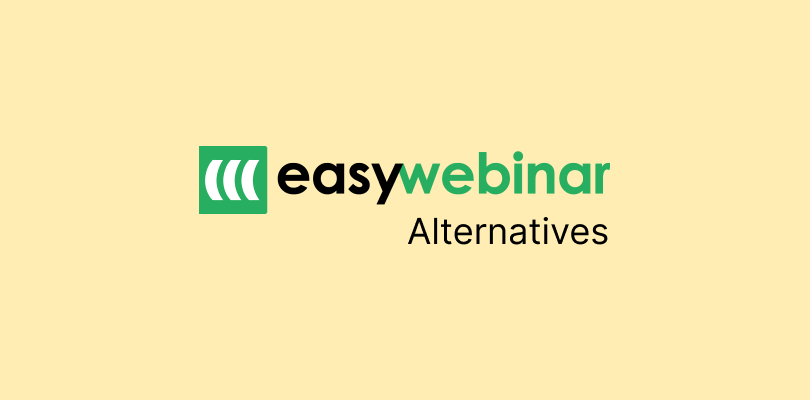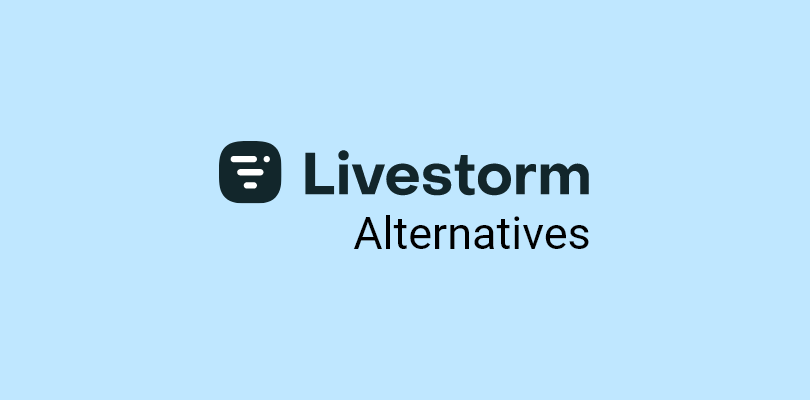Ever had a moment when you couldn’t stop binge-watching a web series, even at 3 AM on a work night? 🎬
That’s the level of engagement the right webcast software can bring to your virtual events. Whether it’s a product launch 🚀, a live Q&A, or a thought leadership session, the right platform keeps your audience glued to their screens.
In fact, with nearly a decade in the webinar industry, I’ve seen how a feature-rich platform can turn an ordinary webcast into something truly engaging.
But what’s the best webcasting software, and how do you get the most out of it?
Here’s a detailed list of webcast platforms, along with tips and benefits to help you create better events 🛠️.
Let’s dive in
| Tool | Best Use Case | Starting Cost |
|---|---|---|
| WebinarNinja | Best Webinar Software to Improve Marketing, Grow Sales, and Teach Better | FREE 14-day trial. Paid starts at $0.30/attendee/month (includes CourseNinja worth $1200). |
| Google Meet | Real-Time Collaboration on Documents | Starts at $6/user/month |
| Microsoft Teams | Microsoft Suite Users | Starts at $4/user/month |
| Webex Suite | Large Meetings & Virtual Events | Starts at $675/user/year. |
| ON24 | Virtual Events | Custom Pricing |
| Crowdcast | Browser-Based Live Video Events | Starts at $34/month for up to 10 hours/month |
| GoTo Meeting | Quick Team Check-Ins | Starts at $12/organizer/month. |
| Zoom | Breakout Rooms | Starts at $149/month for up to 100 attendees. |
8 Best Webcasting Software in 2025
Here is a detailed view of some of the best software with webcasting services, along with their pros, cons, and pricing. This will help you understand these platforms in detail:
1. WebinarNinja
Best Webinar Software to Improve Marketing, Grow Sales, and Teach Better
WebinarNinja feels like the all-in-one webcast software every marketer or educator secretly dreams of. It’s built for hosting webinars that don’t just stream your ideas but help you turn them into action—whether that’s growing sales, building an audience, or teaching more effectively.
What makes it great for webcasts is how effortless it is to engage viewers with live polls, Q&A sessions, and timed offers that keep them glued to the screen.
I’ve seen how its automation features simplify running evergreen webinars while email reminders keep attendees on track. It’s ideal for professionals who want to deliver impactful presentations without stressing about tech hiccups. For me, it’s like having a virtual stage manager, making sure everything runs like clockwork.
What You Will Like:
- WebinarNinja has an easy-to-use, user-friendly interface with a no-code setup to create webcasts easily.
- Automatic recording ensures that webcasts are available for on-demand viewing without additional effort.
- It allows you to monetize your presentations with easy integration of payment platforms.
- It supports branded registration pages, making it easy to promote webcasts with a professional touch.
- Users can access detailed performance analytics to evaluate attendee behavior and optimize future webcasts.
- It integrates seamlessly with marketing platforms like Mailchimp and Zapier for efficient lead management.
- It offers 24/7 awesome customer support to ensure timely resolution of queries and issues.
What You May Not Like:
- No downloadable or on-premise version
- A dark user interface option is not available.
Pricing: A FREE 14-day trial is available. Paid starts at $0.30/attendee/month (includes CourseNinja worth $1200).
2. Google Meet
Best for Real-Time Collaboration on Documents
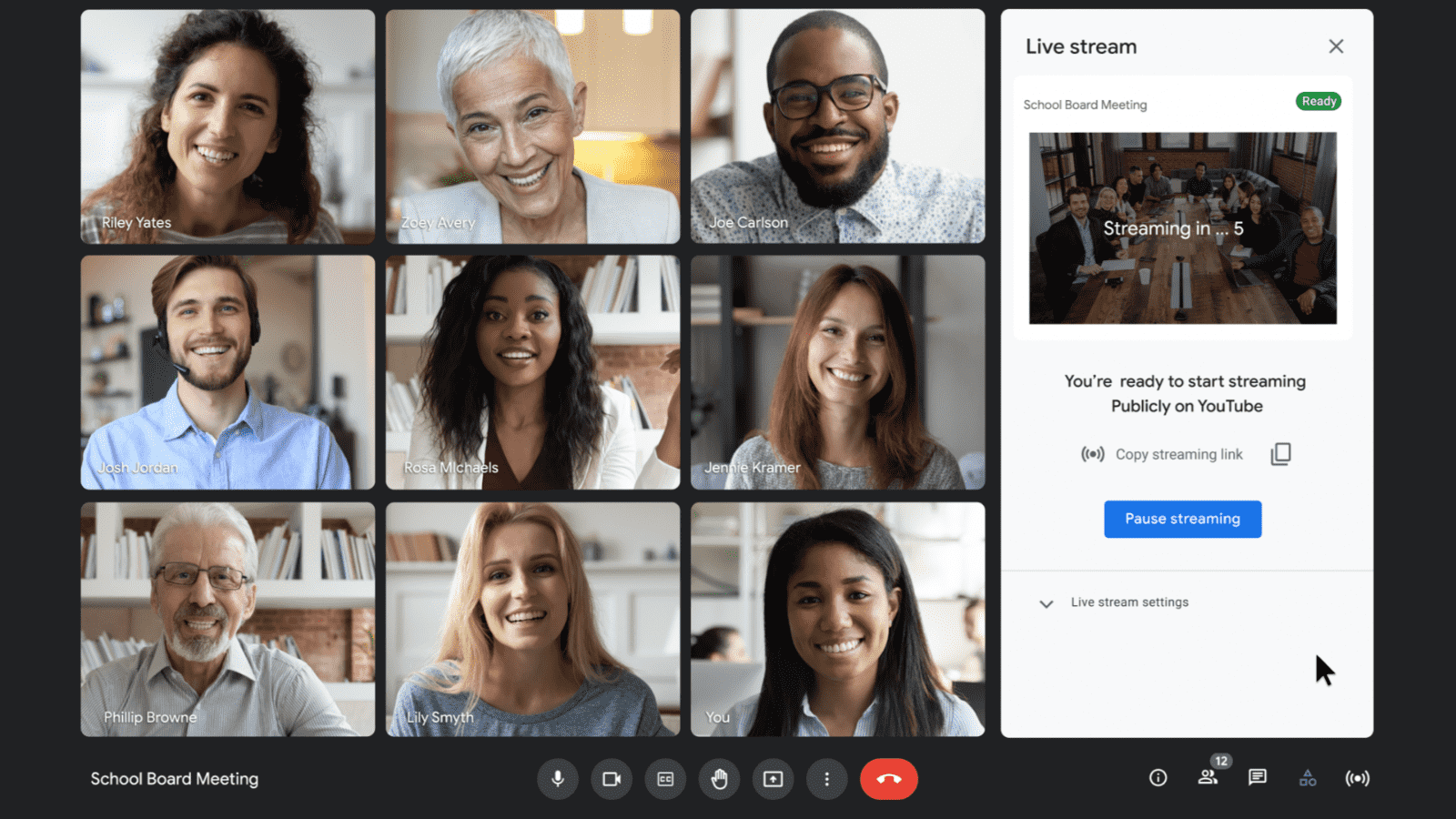
Google Meet is the ultimate meeting platform for teams already living in the Google Workspace ecosystem. What makes it great for webcasts is its ability to keep things interactive while seamlessly integrating with tools like Google Docs.
This makes real-time collaboration during webcasts incredibly smooth, whether you’re tweaking documents, sharing ideas, or keeping everything visible to participants.
It’s handy for smaller, hands-on webcasts where participants need to engage directly with shared files. The browser-based interface is simple to use, and I love how there’s zero software to install.
What You Will Like:
- Google Meet integrates with Google Workspace, enabling seamless scheduling and organization of webcasts directly from your calendar.
- The platform runs entirely in browsers, eliminating the need for additional software installations.
- It supports up to 100 participants in its free plan, which is suitable for small webcasts.
- Real-time live captions ensure accessibility for a diverse audience.
- Screen-sharing options make it easy to present slides, documents, or other visuals during webcasts.
What You May Not Like:
- The platform lacks advanced webcasting services and features like polls or custom engagement tools.
- Branding options are minimal, limiting personalization for professional presentations.
Pricing: Free with limited features. Paid plans start at $6/user/month. Billed annually.
3. Microsoft Teams
Best for Microsoft Suite Users
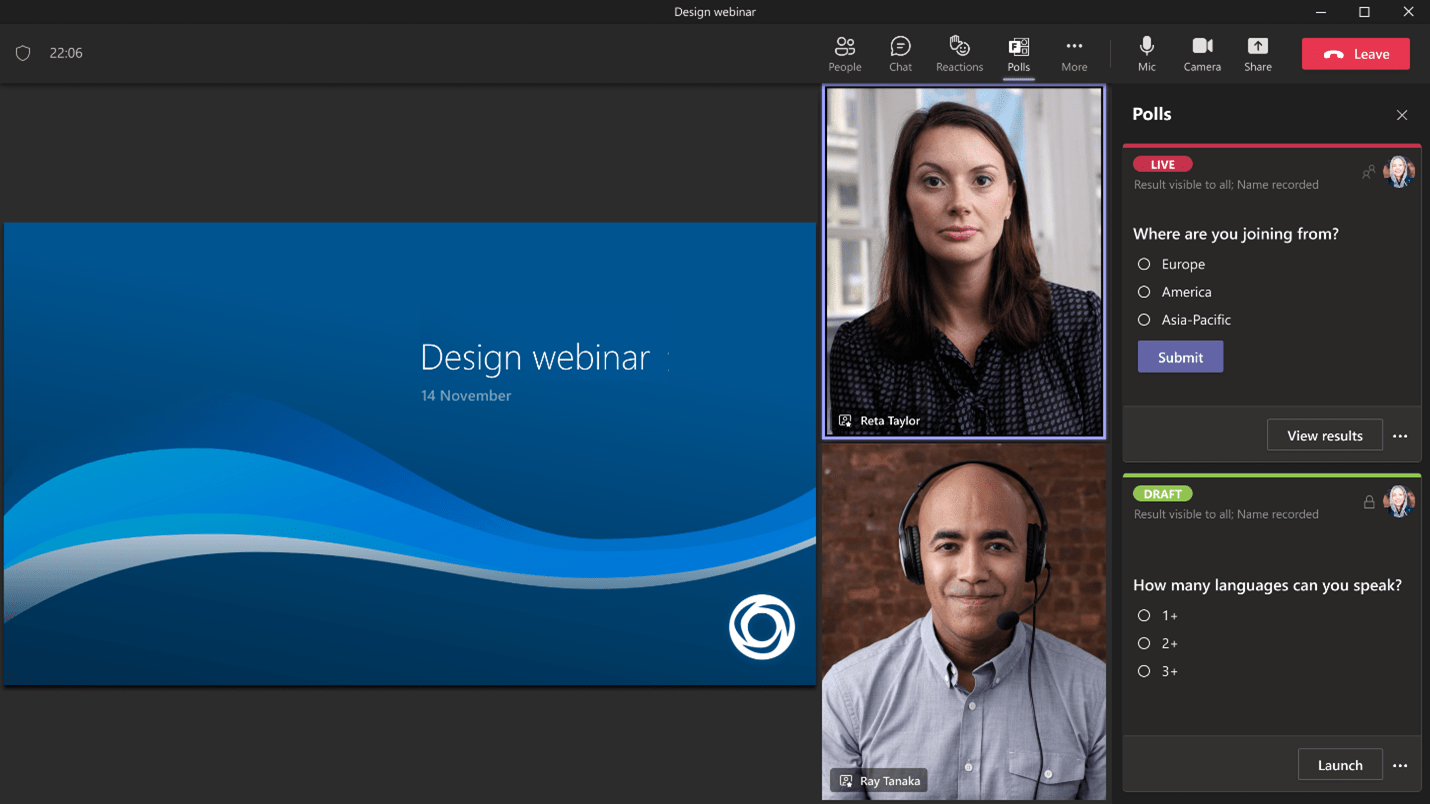
If you’re already using Microsoft Office daily, Teams is the natural choice for webcasts. It’s built to make the most of your Office apps, so you can share PowerPoint decks, co-edit Excel sheets, or pull in Word docs without skipping a beat.
Its integration with the Microsoft Suite is what makes it stand out for webcasts—you’re not just presenting; you’re collaborating live.
I’ve found Teams especially useful for workshops or training sessions where participants need to work on shared projects. Channels keep conversations organized, and scheduling webinars through Outlook feels like second nature.
What You Will Like:
- The platform can host up to 20,000 attendees in view-only mode, making it ideal for large-scale events.
- Robust security features, including data encryption, protect sensitive webcast content.
- Customizable registration pages and attendee reports allow you to measure engagement effectively.
- Interactive features like live polls, Q&A sessions, and chat help maintain audience involvement.
- Session recording includes automatic transcription, enabling easy sharing and reference.
What You May Not Like:
- The multi-layered interface may feel overwhelming for new users.
- A Microsoft 365 subscription is required for full functionality, which could be expensive for smaller teams.
Pricing: Starts at $4/user/month. Billed annually.
4. Webex Suite
Best for Large Meetings & Virtual Events
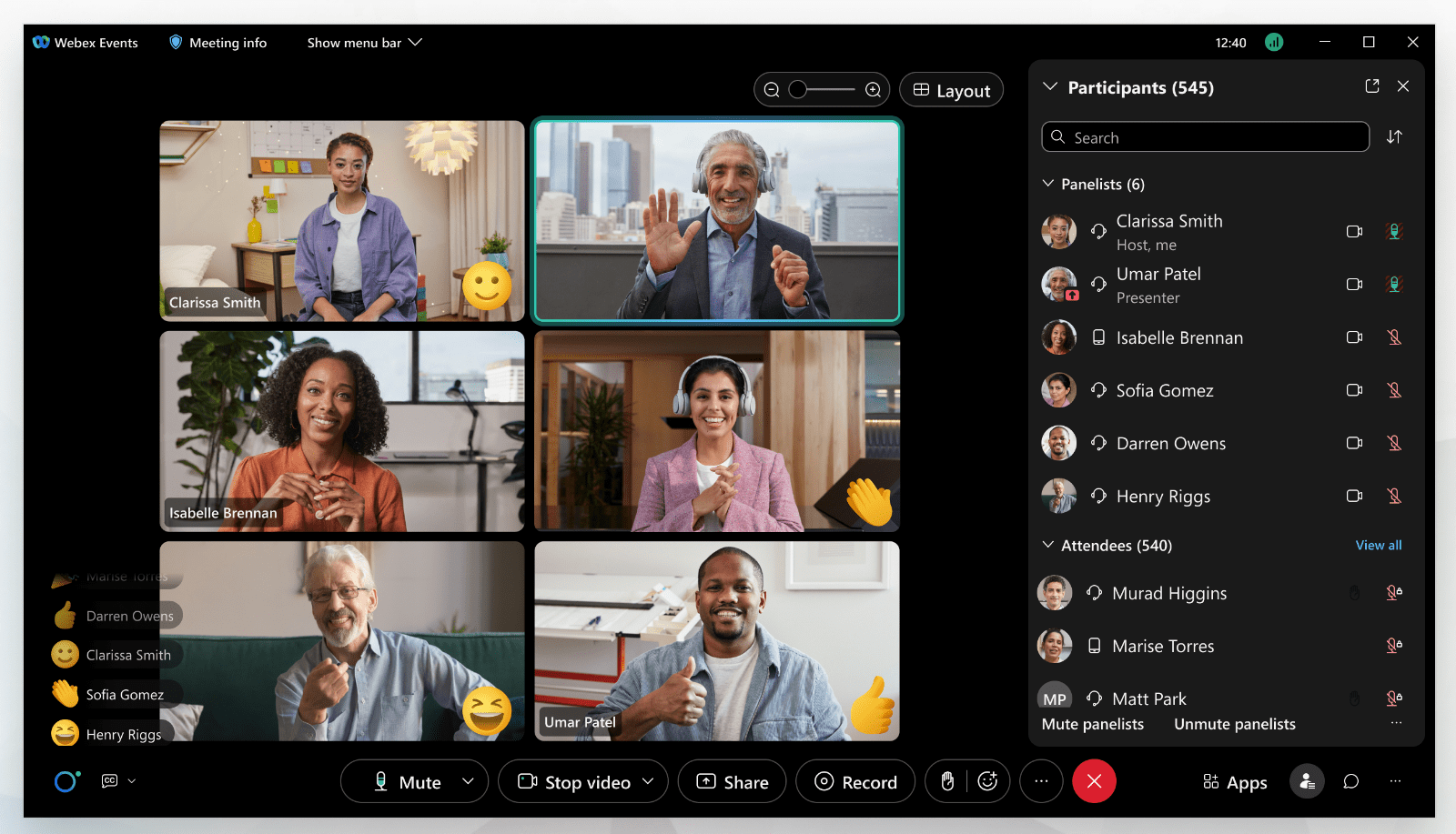
When it comes to pulling off large-scale virtual events, Webex is like your safety net—it’s reliable, professional B2B webcast software, and packed with tools to handle a crowd.
Its ability to host high-quality webcasts, even for massive groups, is what makes it ideal for these scenarios. Features like breakout rooms, live polling, and noise cancellation ensure your event feels smooth and polished, even when hundreds of participants join.
I’ve attended multi-day conferences on Webex, and the experience was seamless from start to finish. The platform’s scalability and stability are perfect for companies hosting large meetings or virtual trade shows. Plus, customizable branding options give your webcasts a professional edge.
What You Will Like:
- Webex Suite supports large-scale webcasts with up to 100,000 attendees, ideal for significant events.
- High-definition video streaming ensures a professional look for your webcasts.
- Advanced security features, such as end-to-end encryption, safeguard sensitive webcast content.
- The platform offers extensive customization options for branding and layouts.
- Integration with third-party applications enhances functionality for various use cases.
What You May Not Like:
- The user interface can feel outdated compared to more modern tools.
- The mobile app lacks some functionalities available on the desktop version.
Pricing: Starts at $675/user/year for up to 1000 attendees.
5. ON24
Best for Virtual Events
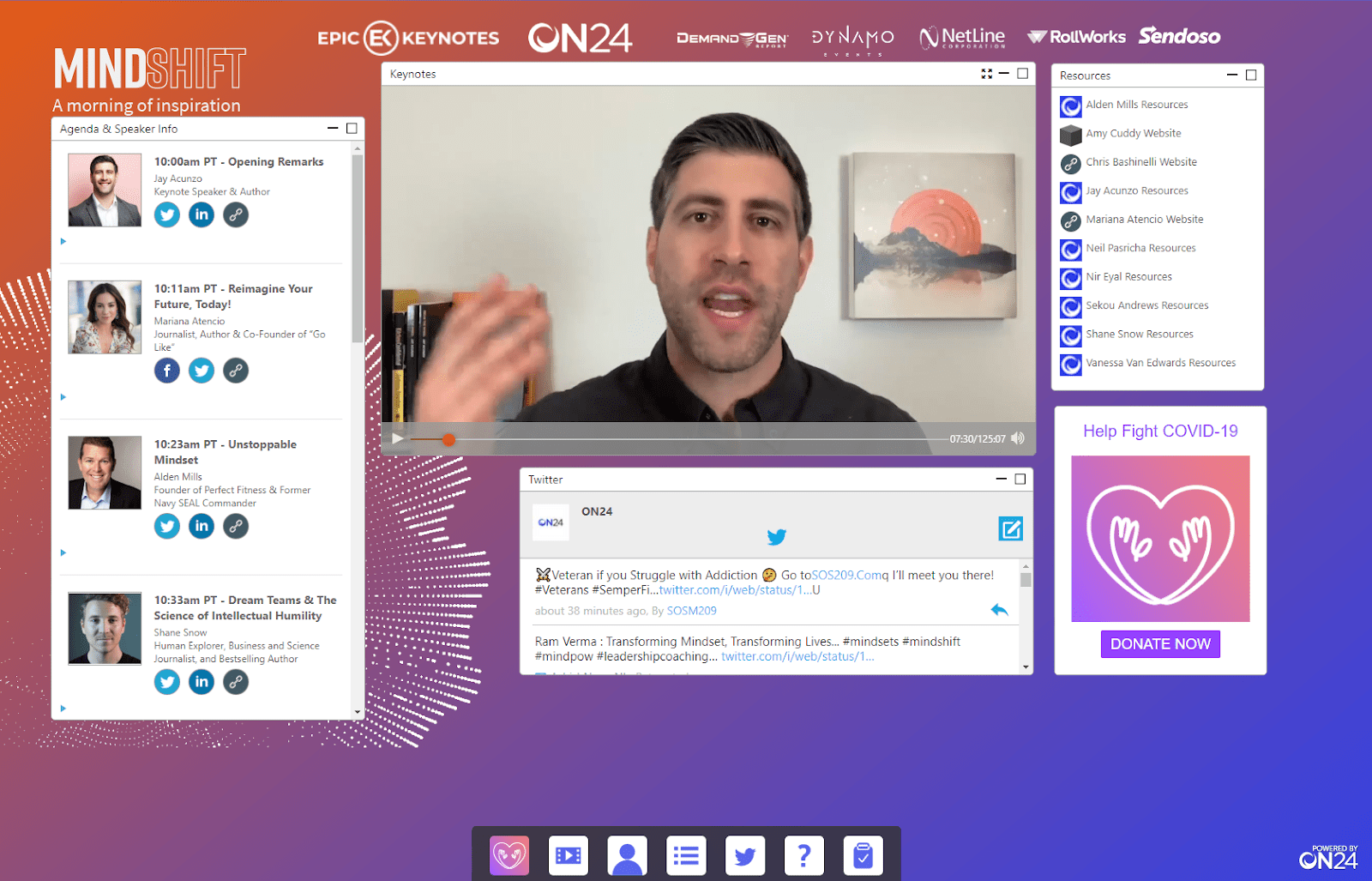
ON24 is like having a production studio in your back pocket, making it ideal for high-quality virtual events. What makes it great for webcasts is its focus on engagement—quizzes, polls, and resource downloads make your audience feel like active participants rather than passive viewers.
It’s a go-to for marketers and event planners who need more than just a streaming platform. I’ve seen ON24 used for corporate webinars where tracking attendee engagement was critical, and the insights it provided were invaluable. If you’re hosting professional-level virtual events, this platform ensures everything looks polished and runs smoothly.
What You Will Like:
- The platform offers advanced analytics to track audience engagement and behavior during webcasts.
- It supports various formats, including live, on-demand, and simulive (pre-recorded content with live Q&A).
- Seamless CRM integrations streamline follow-ups after webcasts.
- Users can share resources such as downloadable materials during live sessions.
- Strong customer support helps ensure smooth setup and delivery of webcasts.
What You May Not Like:
- The platform’s complexity may require a learning curve for new users.
- Limited flexibility in webcast formats compared to other tools.
Pricing: Custom pricing.
6. Crowdcast
Best for Browser-Based Live Video Events
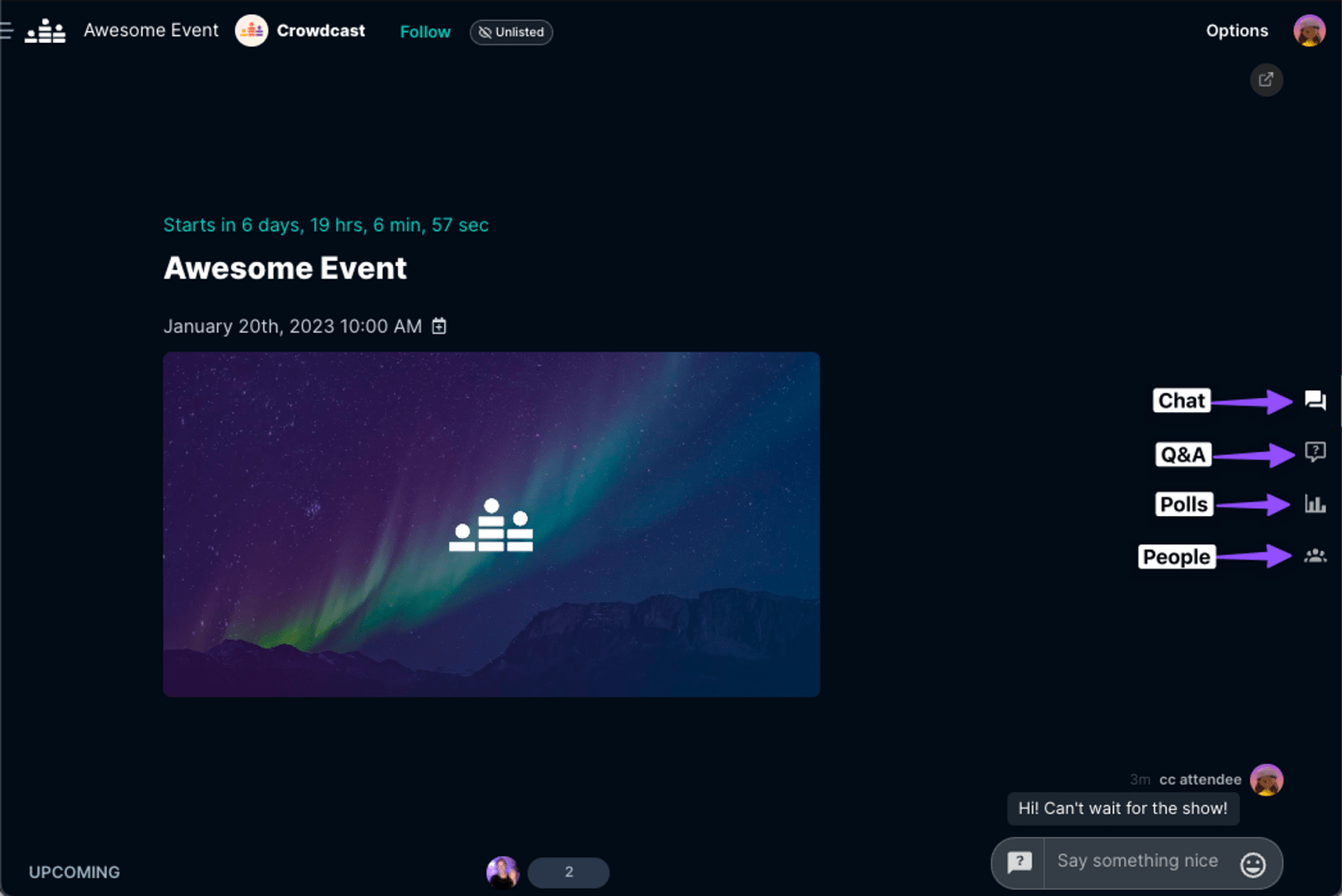
Crowdcast is another good webcast software that makes hosting live video events as easy as sending a link; no downloads are required. Its browser-based simplicity is what makes it so good for webcasts. It keeps things hassle-free while offering robust features like Q&A sessions, polls, and audience engagement tools.
I’ve used it for casual webinars and panel discussions, and the experience felt natural and interactive. Bringing audience members on screen to join the conversation is a standout feature. It’s ideal for creators or teams looking for an easy-to-use platform to engage with viewers without any tech headaches.
What You Will Like:
- Crowdcast’s simple interface makes it easy to set up webcasts without requiring technical expertise.
- Real-time analytics provide actionable insights during webcasts, helping hosts make informed adjustments.
- Built-in social sharing options boost event visibility across platforms.
- Users can monetize webcasts using ticketing options directly within the tool.
- Integration with platforms like Patreon and Shopify supports creator-focused webcasts.
What You May Not Like:
- Crowdcast lacks advanced features such as automated follow-up emails.
- Audience size is capped in lower-tier plans, which limits scalability for larger webcasts.
Pricing: Starts at $34/month for up to 10 hours a month.
7. GoTo Meeting
Best for Quick Team Check-Ins
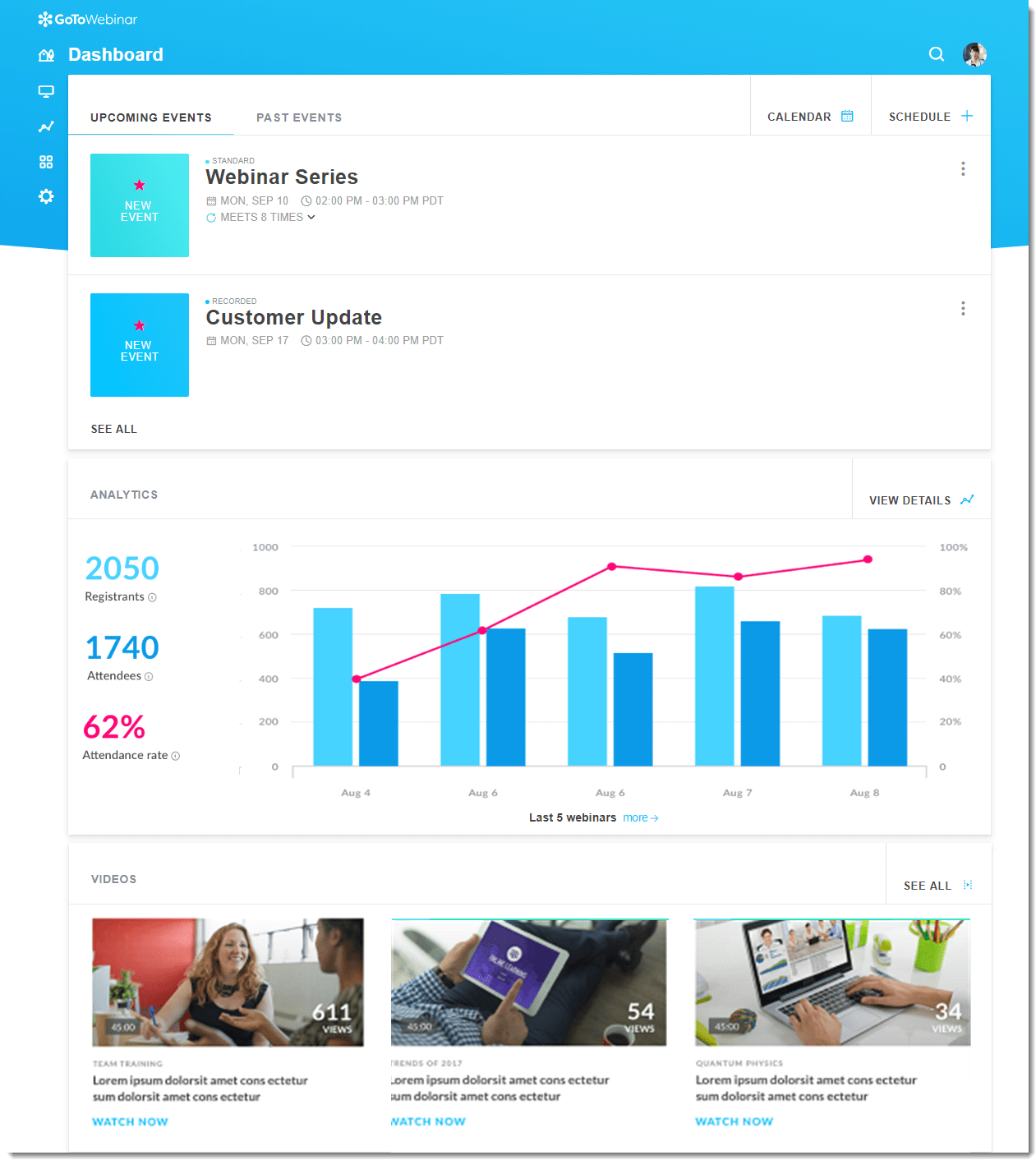
GoTo Meeting is all about simplicity, and that’s what makes it perfect for quick team check-ins or straightforward webcasts. While it’s not loaded with extensive features, it’s dependable and easy to use, making it ideal for fast-paced teams that need to connect and share updates.
What makes it great for webcasts is its focus on providing high-quality audio and video streaming, ensuring professional delivery for small and medium-sized events.
I’ve found it especially handy for hosting smaller group meetings or updates where seamless communication is the top priority. The added features like presenter drawing and annotation make it a bit more interactive without overcomplicating things.
What You Will Like:
- The platform includes tools like presenter drawing and annotation to enhance live sessions.
- Automated follow-up emails help maintain audience engagement after the webcast.
- Users can access detailed analytics to measure attendee participation and gather feedback.
- Session recordings are easy to share, enabling on-demand access for those who missed the live event.
- Scalable plans cater to both small teams and enterprise-level organizations.
What You May Not Like:
- Branding options are restricted in lower-tier plans.
- Integration options with third-party tools are limited compared to competitors.
Pricing: Starts at $12/organizer/month. Billed annually.
8. Zoom
Best for Breakout Rooms
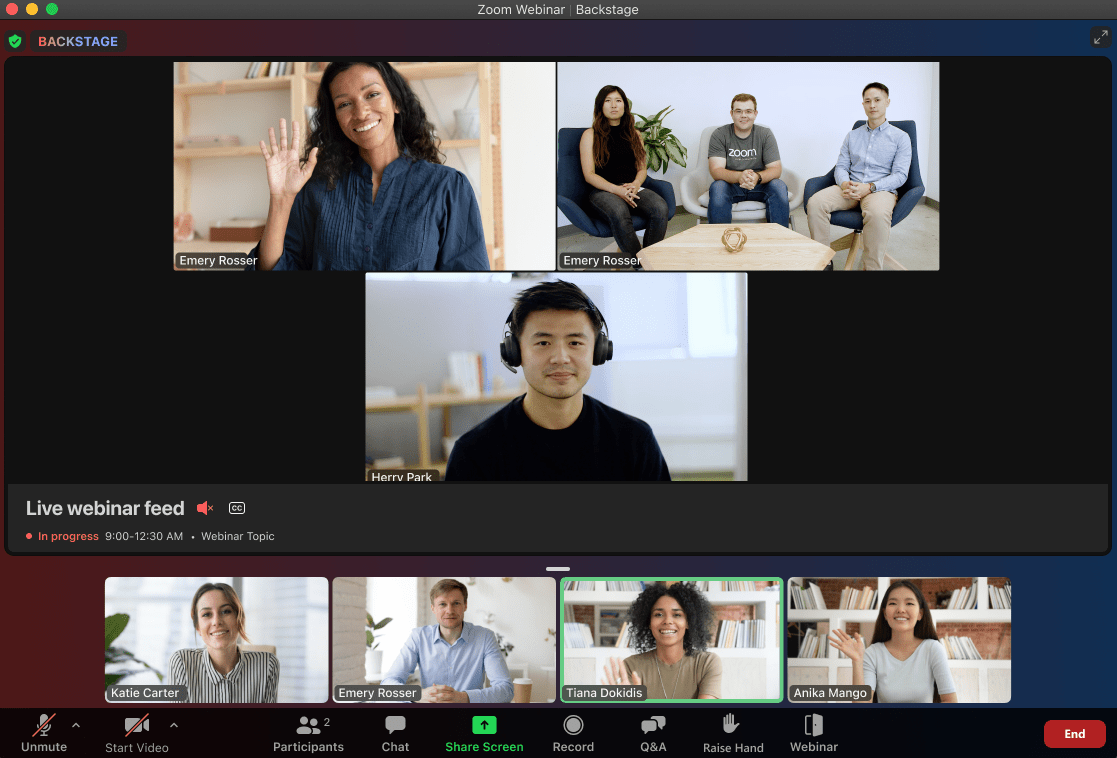
Zoom has become a household name in video conferencing, and its breakout rooms feature is a standout when it comes to webcasts. Whether you’re hosting workshops, training sessions, or brainstorming meetings, this functionality creates a collaborative atmosphere by allowing participants to work in smaller groups.
For webcasts, it’s a fantastic platform for keeping audiences engaged and active throughout the session.
I’ve used Zoom in the past for interactive webcasts, and it’s incredible how easily you can shuffle participants or drop in to check on progress. Its scalability also makes it a strong option for teams of any size, and the robust engagement tools like polls, Q&A, and hand-raising add an interactive element that many other platforms lack.
What You Will Like:
- Scalable plans support small teams as well as large-scale webcasts with thousands of attendees.
- Live transcription and translation features make it suitable for global audiences.
- Session recordings include cloud storage, ensuring easy access and distribution.
- Robust security settings, such as passcodes and waiting rooms, enhance privacy during webcasts.
- Zoom integrates with a wide range of third-party applications for enhanced functionality.
What You May Not Like:
- The free plan restricts sessions to 40 minutes for groups larger than three participants.
- Privacy concerns have been raised in the past, although the platform has made improvements.
Pricing: Starts at $149/month for up to 100 attendees.
Evaluation Criteria for Webcasting Software
The evaluation process for this blog is customized to webcasting software, ensuring a fair, insightful, and purpose-driven review. This approach is designed to highlight tools that excel in delivering exceptional webcast experiences. The following six key factors were considered:
- User Reviews and Ratings
Real-world feedback from users on reputable platforms provided valuable insights into the software’s performance. This feedback sheds light on both strengths and potential shortcomings, ensuring an audience-focused perspective. - Webcast-Specific Features
The evaluation prioritizes features critical for webcasts, such as interactivity tools, engagement metrics, and scalability. The tools were examined for their ability to meet diverse webcast needs, from hosting large-scale events to supporting collaborative sessions. - Ease of Use
The usability of each platform was assessed, focusing on its interface, setup process, and learning curve. This ensures that the tools reviewed are accessible to users with varying levels of technical expertise, making webcasts seamless to host. - Customer Support and Reliability
Reliable support is a cornerstone for successful webcasts. Platforms were evaluated based on the quality of assistance provided during setup, troubleshooting, and post-event needs. Stability and reliability under high traffic were also key considerations. - Cost-Effectiveness
The tools were assessed for their pricing in relation to the features offered. This helped determine if the software delivers value for its cost, catering to businesses of all sizes and budgets. - Real-World Insights
The evaluation incorporates personal experiences and insights from industry experts. This practical perspective ensures the review goes beyond surface-level features, offering a relatable and trustworthy analysis for readers.
What Are the Features of Good Webcasting Software?
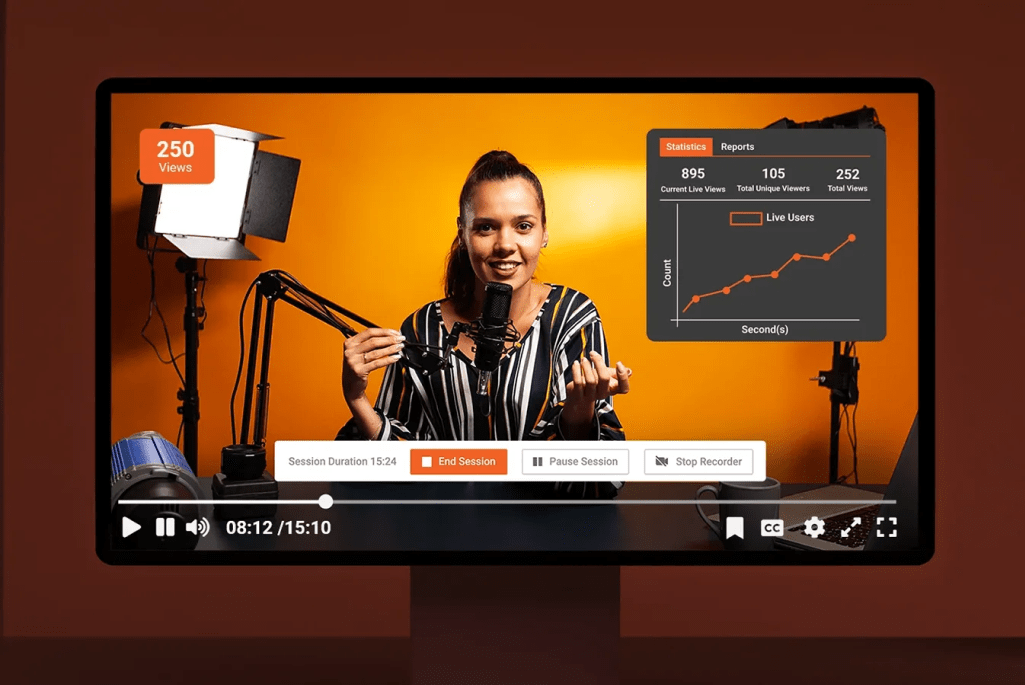
Some of the key features of good webcasting software are as follows:
- High-Quality Streaming
A reliable webcasting platform ensures top-notch video and audio quality with minimal latency. Adaptive streaming capabilities help adjust quality based on viewers’ internet speeds, providing a seamless experience for global audiences. It supports HD resolution and clear audio delivery, making it ideal for professional presentations, live events, or broadcasts requiring superior production value.
- Multi-Device Compatibility
A robust webcasting solution works effortlessly across devices, including desktops, tablets, and smartphones. It offers responsive design and functionality, ensuring viewers can join from any device without needing to download additional software. This accessibility broadens audience reach and provides a flexible viewing experience, regardless of location or device type.
- Real-Time Engagement Features
To keep viewers engaged, top webcasting platforms integrate live chat, polls, Q&A sessions, and emoji reactions. These tools foster active participation and real-time interaction between hosts and attendees. Features like moderated chat and spotlight Q&A further enhance the experience, making it dynamic and interactive for all participants.
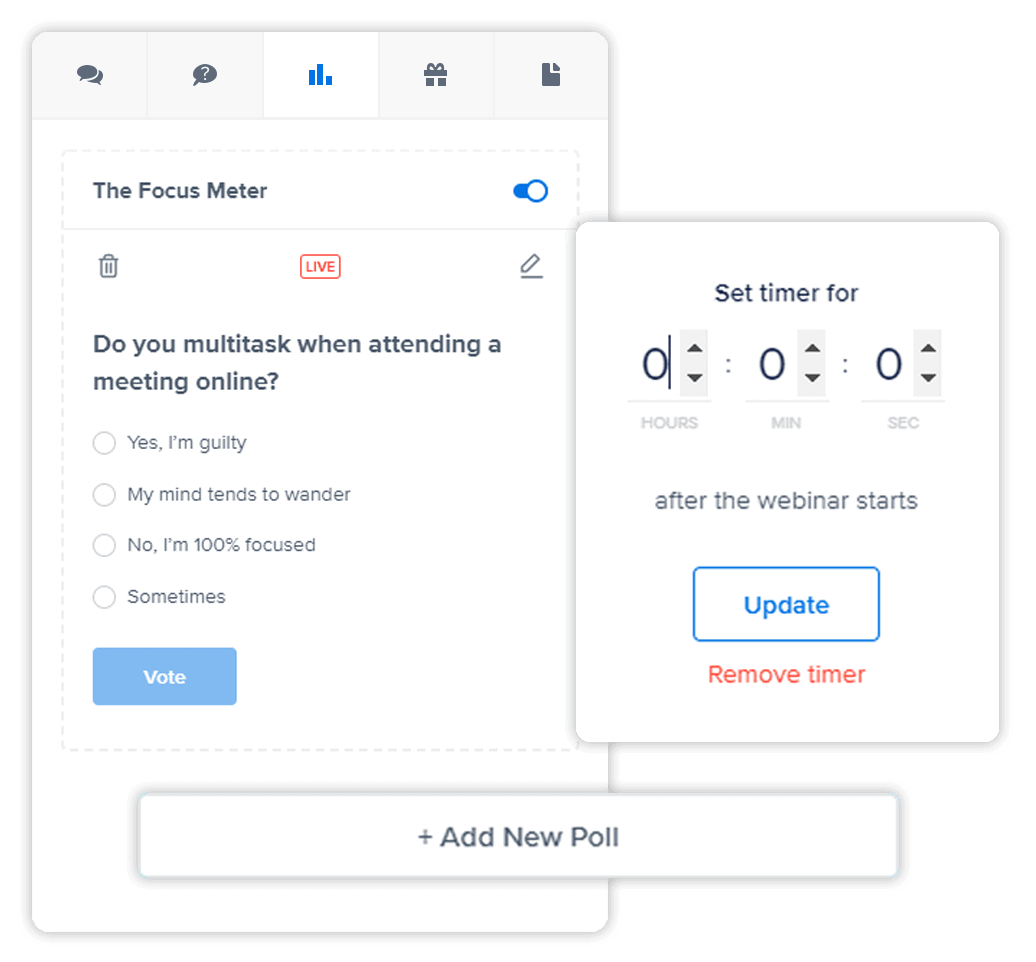
- Custom Branding Options
Customizability is crucial in professional webcasting. Platforms offer features like branded registration pages, logo inclusion, and personalized color themes to align with the host’s identity. This ensures consistency in messaging and enhances the professional appeal of broadcasts, creating a lasting impression on the audience.
- Scalability for Large Audiences
A good webcasting software supports a large number of concurrent viewers without compromising quality. It is built to handle scalable virtual events, from small internal meetings to massive live broadcasts with thousands of attendees, ensuring stability and reliability under high-traffic conditions.
- Advanced Analytics and Reporting
Webcasting platforms include detailed metrics on audience behavior, engagement levels, and session performance. Hosts can access insights like attendee demographics, viewing duration, and interaction rates. These analytics enable data-driven decisions for follow-up and help refine strategies for future broadcasts.
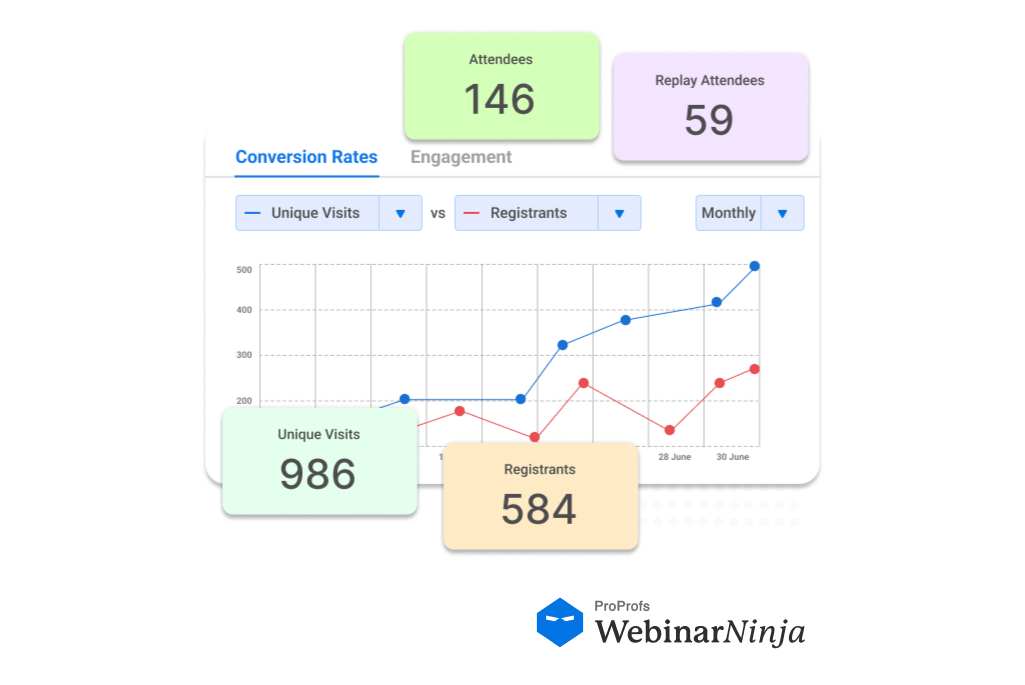
- Event Automation Features
Automation tools like scheduled broadcasts, automated follow-ups, and pre-recorded video integration make webcasting seamless. These features allow hosts to streamline repetitive tasks, freeing them to focus on content and interaction. Automation also improves time efficiency and ensures consistent delivery across sessions.
- Seamless Integrations
Webcasting platforms support seamless integrations with CRM tools, email marketing services, and analytics platforms. This enables smoother workflows, from managing attendee data to post-event follow-ups. API support is often included for custom solutions, making the software adaptable to various business needs.
- Robust Security and Privacy
Security is a cornerstone of any webcasting platform, offering features like end-to-end encryption, secure data storage, and password-protected access. Hosts can implement restrictions such as registration approvals or unique attendee links to safeguard their broadcasts and maintain control over their content.
- Multi-Presenter Capability
Good webcasting software supports multiple presenters, enabling team collaborations, panel discussions, or guest appearances. It provides intuitive tools for presenter handoffs, screen sharing, and backstage communication, ensuring smooth contributor coordination during live events.
Top Tips for Delivering High-Quality Webcasts
If only you could have Aladin’s lamp, the genie could grant you the wish to create high-quality webcasts forever.
Cut to reality: you can’t get a genie at this point, but I can offer you tips to deliver amazing webcasts every time you try. Here are some of them:
1. Create “Planned Spontaneity”
Spontaneous moments engage audiences, but they don’t always have to be truly off-the-cuff. Plan lighthearted comments, jokes, or interactive moments that feel organic while reinforcing your message.
Example: During a marketing webcast, casually say, “Alright, who’s ready for a mini magic trick? Let’s turn low CTRs into high conversions in three steps,” while using a slide with playful visuals.
2. Use Dynamic Camera Angles
Emulate a professional studio by switching between different camera angles. Transitioning from a close-up to a wider view or shared screen keeps the webcast visually dynamic and prevents viewer fatigue.
Example: In a training session, use a close-up camera while making an important point, then zoom out to show a whiteboard or physical props for a demonstration.
3. Leverage the Chat to Build Anticipation
Engage the audience early by dropping hints about valuable insights or exclusive content they’ll gain later. This keeps viewers invested and curious about what’s coming next.
Example: Early in the session, say, “In about 15 minutes, I’ll share a tip that helped my team triple our productivity. You’re going to love it!”
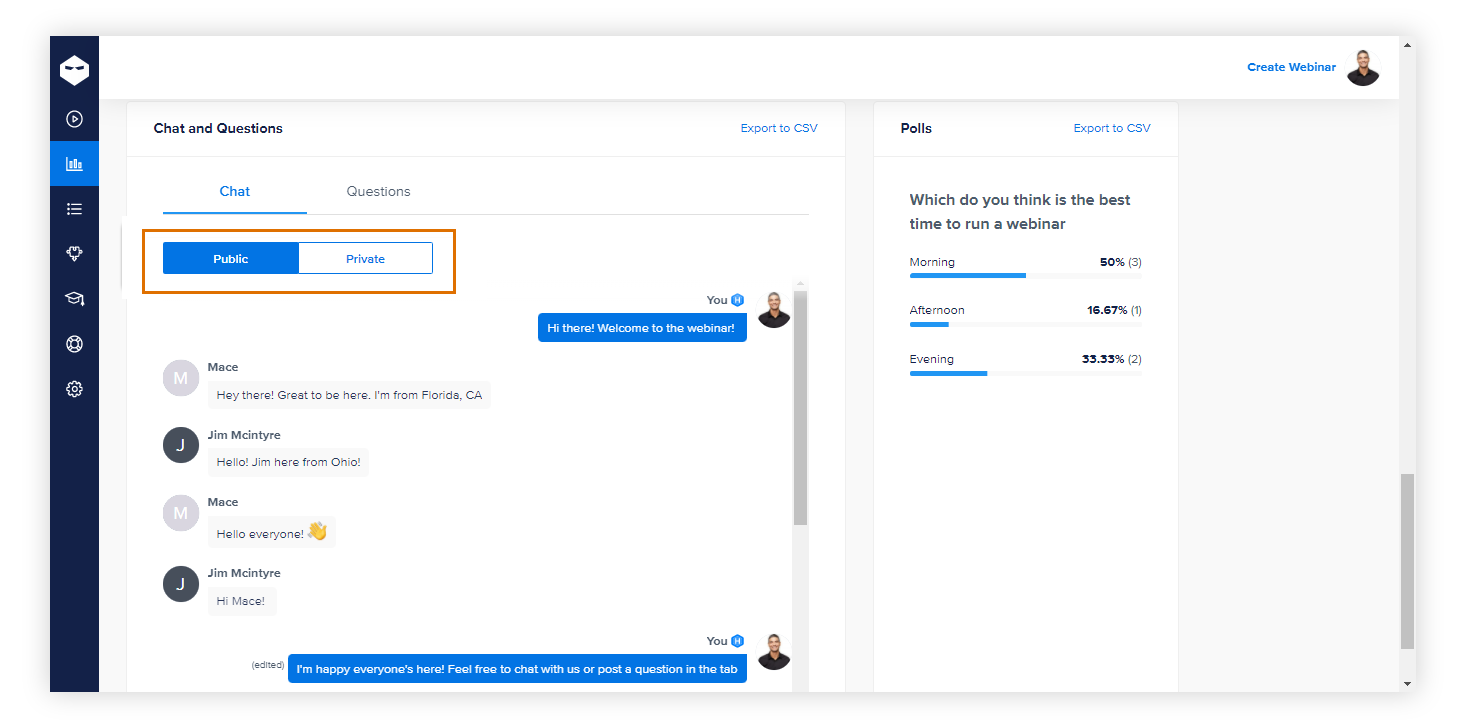
4. Build Real-Time Gamification
Create an interactive challenge or game tied to the webcast’s topic to energize the audience and encourage participation. Small rewards like shout-outs or handouts add an extra incentive.
Example: Ask attendees to guess a statistic related to the topic, using the polling feature. Offer a free resource to the first three correct responders, such as a template or cheat sheet.
5. Master the “Intentional Pause”
Silence is a powerful tool in communication. After sharing a major point, pause briefly to let the audience process it, reinforcing the message’s impact. It also gives you time to reset mentally.
Example: After explaining a breakthrough strategy, pause for a moment and say, “Think about how this could apply to your next project.” This creates reflection and keeps your audience engaged.
6. Add a Personal Backstory or Anecdote
Connecting emotionally through storytelling humanizes your presentation and makes your message relatable. Use concise, relevant stories that highlight challenges and solutions.
Example: If discussing leadership, share how a simple team-building activity turned around a struggling project, making it more relatable and actionable for the audience.
7. Use QR Codes for Real-Time Engagement
Incorporate QR codes during the webcast to link attendees to specific actions, such as downloading resources, completing surveys, or accessing a special webpage. It’s a simple way to encourage immediate participation.
Example: Display a QR code midway, leading to an exclusive worksheet that complements the current topic. Mention that it’s only available during the webcast for urgency.
8. Incorporate Silent Cues for Team Communication
Develop a system of non-verbal cues between the presenter and the support team to address technical or timing issues discreetly. This ensures a smooth presentation without alerting the audience.
Example: Use hand signals or a specific sticky note color to indicate when to adjust the slide pace or alert the team about an issue, such as low sound quality.
9. Simulate Eye Contact
To create a personal connection with viewers, position your notes or teleprompter close to the camera lens. This keeps your gaze focused on the audience rather than appearing distracted by off-camera cues.
Example: Stick brief bullet points near the webcam to maintain natural eye contact while covering key points seamlessly.
10. Embed Live Social Proof
Real-time validation increases trust and excitement. Highlight comments, testimonials, or live poll results as they happen to reinforce your message and show audience participation.
Example: Share a live chat comment like, “This strategy is brilliant—our team needs this!” when discussing actionable tips, making others feel inspired to follow along.
11. Surprise the Audience with Hidden Gems
Delight attendees with unadvertised bonuses or exclusive offers during the session. This not only keeps their attention but leaves them feeling rewarded for staying engaged.
Example: Near the end of the webcast, reveal a surprise, like free access to a premium webinar replay or a downloadable checklist. “This wasn’t on the agenda, but here’s a bonus just for you!”
12. Optimize for Mobile Viewers
Since many viewers join via mobile devices, ensure your webcast visuals and content are designed with smaller screens in mind. Use bold text, fewer elements per slide, and high-contrast colors.
Example: Before the webcast, preview your slides on a phone. Ensure text remains legible and images are clear, avoiding fine details that may get lost on smaller screens.
Key Benefits of Using Good Webcasting Software
Here are some of the major benefits of using a reliable webcasting solution:
- Stream Seamlessly with High-Quality Video and Audio
Good webcasting software ensures that your content is delivered in crystal-clear resolution and sound. This enhances the viewer’s experience, keeps them engaged, and eliminates distractions caused by technical glitches.
- Expand Your Reach Across Diverse Platforms
Webcasting tools often integrate with multiple platforms, enabling you to stream simultaneously on social media, websites, or proprietary apps. This maximizes your audience potential and improves your brand’s visibility.
- Engage Your Audience with Interactive Features
Advanced webcasting software includes features like live polls, Q&A, and chat options. These tools foster real-time interaction, keeping your audience involved and boosting their overall satisfaction.
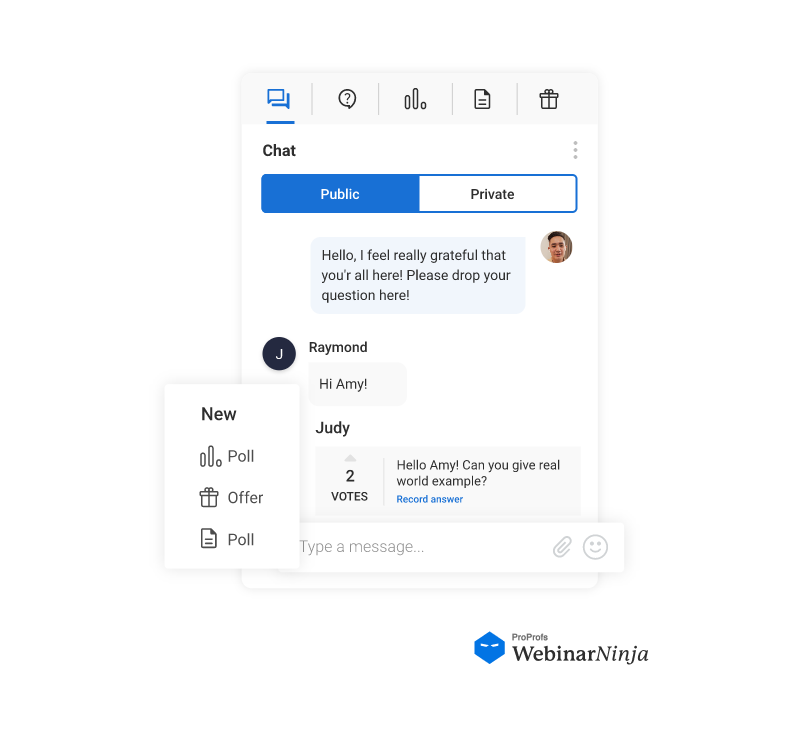
- Save Time with Easy-to-Use Interfaces
User-friendly interfaces and automation options reduce the learning curve and setup time. This allows hosts to focus on content quality rather than technical operations.
- Analyze Your Performance with Built-In Analytics
Built-in analytics tools provide real-time data on viewer numbers, engagement rates, and demographics. These insights help you refine your strategy for future events and measure the success of your webcasts.
- Secure Your Content with Advanced Encryption
Reliable webcasting software offers encryption and password protection features, ensuring your content remains secure and accessible only to intended viewers. This is crucial for sensitive or exclusive broadcasts.
- Scale Effortlessly for Larger Audiences
High-quality software is built to handle large-scale events without compromising performance. This scalability supports smooth streaming for small meetings or global webinars.
- Enhance Branding with Customization Options
Branding features like personalized logos, layouts, and themes allow you to align the webcast with your brand identity. This creates a professional and cohesive impression on viewers.
Ready to Use Reliable Webcasting Software?
If you are a business looking to engage audiences globally, whether for webinars, training, or product launches, you surely need a good webcasting platform.
Choosing the best webcasting software can elevate your online events, ensuring smooth communication and impactful presentations. It’s all about finding a platform that matches your goals, audience size, and content needs.
Among the tools I listed, I really like WebinarNinja’s features, which make it easy to create, host, and deliver seamless presentations. Whether you’re aiming to inform, educate, or sell, it can help you achieve professional-grade results while keeping the experience simple and effective for you and your audience.
Want to host a webinar for free?
Use WebinarNinja to teach, improve marketing, and grow your sales.




